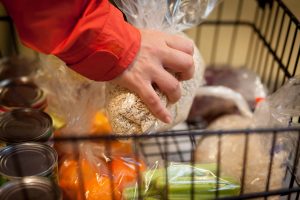 Beverly* had been homeless off and on for a long time. One by one, she lost her teeth until she had none. The factors involved in this loss were more complicated than, “I don’t like to brush my teeth,” and Beverly wouldn’t wish this situation on anyone. Her story follows a predictable pattern common in people experiencing homelessness.
Beverly* had been homeless off and on for a long time. One by one, she lost her teeth until she had none. The factors involved in this loss were more complicated than, “I don’t like to brush my teeth,” and Beverly wouldn’t wish this situation on anyone. Her story follows a predictable pattern common in people experiencing homelessness.
When you’re homeless, you don’t have consistent access to running water or a sink, not to mention a toothbrush or floss, so it’s difficult to care for your teeth. Add to that a nutritionally poor diet of whatever you can get your hands on — which could be food that is spoiled, doesn’t require cooking or that you can buy with loose change — and you have a dentist’s nightmare.
Extraction is the least expensive way to treat decaying teeth and often the only one that homeless people have. If it gets painful enough, people experiencing homelessness sometimes pull their own teeth.
But pulling teeth is more than one kind of painful. Missing teeth reduce self-esteem and personal appearance, making it that much harder to find a job or rent an apartment. Painful and missing teeth also reduce the likelihood that a person will get sufficient calories and balanced nutrition.
Even if dental care becomes available later, dentures may not be an option if, as in Beverly’s case, the jaw bone deteriorates. When the jaw bone deteriorates because of poor nutrition and lack of oral care, the muscles used to chew and swallow lose their strength. This increases the chance of complications, from difficulty speaking to choking.
While Beverly is now living in an apartment, thanks to assistance from various local services, she relies on SNAP, also known as food stamps, and her local food bank at Jewish Family Service. Beverly likes to come to the Food Bank because she’s treated “with respect and like a human being.” She can’t eat sugar anymore because she has diabetes, and she’s on a low-fat diet to help control her cholesterol. Add those to her lack of teeth and having any food options is counted as a blessing.
Beverly usually finds options that work for her at the Food Bank. She chooses carrots and other raw vegetables that she can steam until they’re soft enough to manage. Fruit like bananas are also wonderful, and she loves it when JFS has low-fat yogurt. She says it’s nice when the Food Bank has healthy slurpable alternatives like applesauce.
On top of providing people like Beverly access to food that meets their individual needs, JFS can help in other ways, noted Susan Rogel, Director of Emergency Services. “For someone like Beverly, we can assist with medical or dental costs. This frees up money for rent or utilities, and can help prevent eviction or a return to homelessness,” Rogel said.
Despite her challenges, Beverly presses on through life with determination. She volunteers at food banks around the area and does her best to treat others kindly. “Being treated like a human being keeps me coming back,” and she wants to pass that along to others.
The interview with this client was done as part of a Polack Food Bank focus group convened to help JFS better understand how it is serving vulnerable individuals and families experiencing food insecurity. This post is adapted from a story by Laura Day and is courtesy of Food Lifeline. Food Lifeline distributed over 100,000 pounds of food to JFS in 2016.
*Name changed for client confidentiality.



